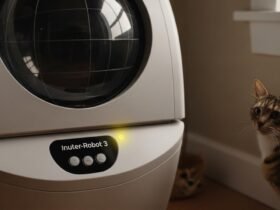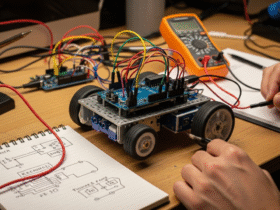You finally decided to gift yourself a little tech-love on the floor, and a robot vacuum glided into your life. Relaxing at home now feels possible because, honestly, who has time to sweep?
Fast-forward to the moment you pour a snack, and that red light starts a slow panic dance. Wait, is that a series of beeps or just your smartphone buzzing with unknown alerts?
A buddy of mine once stared at the screen, her face frozen in confusion, and muttered, What in the name of torque is a torque fault code? You’re not alone, trust me.
Good news: that terrifying words-in-all-caps message is one of the top three reasons these machines cough up warnings. It pops up on Roombas, Sharks, Roborocks- almost every modern vacuum on autopilot.
Even better news: the error nearly never spells doom for the little robot. Most of the time, it means something quiet, ordinary, and fixable- has jammed its wheels or ground up the brush.
Think of it as the motor’s way of saying Hey, Im stuck here; please lend a finger. A ten-minute rescue with a pair of scissors and a flashlight usually sets everything right.
Key Takeaways
- A torque fault pops up when the motor senses too much drag.
- Wrapped brushes, pinched wheels, or a rogue carpet fringe are the usual suspects.
- A dead battery or a set of worn-out gears can sneak up on you and light up that annoying error message without warning.
- Give the sensors a quick wipe and hit the reset button; most of the time, the problem packs its bags and leaves.
- You dont have to call in p; keep your eyes open and handle the machine with a little everyday TLC.
Understanding What Torque Fault Actually Means
Torque sounds like something a mechanic would shout over a power tool, yet every robot vacuum understands the word.
In everyday terms, torque is the twist the motor uses to shove wheels or brushes around. When that twist suddenly spikes because some part is stuck, the machine flashes a fault code and locks its motor to avoid frying the electronics.
That code on your screen is the vacuum’s way of saying Whoa, easy there.
This isn’t bad programming nor an oops from the assembly line; think of it as a seatbelt that clicks tight before you hit the brakes.
Most importantly, you shouldn’t look past the alert, yet there is no rush to swap out parts before you get a look inside. Nine times out of ten, the trouble hides behind a single hairball or a piece of cardboard wedged where it shouldn’t be.
First Sign: Hair or Thread Wrapped Around the Brush Roll
Do you have pets that shed like crazy or long hair that drapes over everything? Maybe your throw rugs give up little fuzzies now and then.
Boom-you might already have the classic clog. Over weeks, the main brush roll acts like a lint roller from the 1980s. At first, you hardly notice, but eventually, the motor finds itself wading through a thick rope of strands.
Flip the vacuum on, and it sounds strong; then check the brush light freezes and the wheels budge.
A sensor notices no spin, throws a fault code, and the display blinks at you. I once fished out six inches of dental floss from my own machine on a total whim- do not ask. The fix takes a side trip to the bottom panel, where you snip or slice the tangle free.
Try moving the brush by hand; if it glides, mission accomplished. Let the battery top off, take it for a quick test glide, and see if the alert returns. More often than not, it doesn’t.
Second Sign: Wheels Not Spinning as They Should
Shifting gears i-ve seen torque faults sneak in through the wheels all by themselves.
Those rubber side wheels that let your robot zip around the house are small but tough. Still, they can choke up in a hurry. Loose threads, a rough rug corner, or even a stray screw can sneak inside the wheel guard and cause a mess.
The problem usually shouts at you in pauses. One second, the cleaner is humming; the next, it jerks and quits.
If the machine is programmed to think, it might back up, scan for a second, then try again. Tech-savvy, right?
Torque sensors tell the brain a wheel is stuck, and the robot waves a panic flag.
When that warning flashed on my screen, I flipped the switch off. Turning each wheel by hand, I noticed one spun freely while the other barely moved.
Shining a small light into the gap showed me a stubborn knot of yarn wedged deep in the axle.
A quick tug with tweezers pried out the thread, and the wheel clicked back into place. After a simple reset, the vacuum hummed off to finish its route without a hitch.
Third Sign: Getting Stuck on Thick Rugs or Transitions
Let’s be honest: every one of us digs the look and feel of one of those cushy, shaggy living room rugs. But your little robot sidekick? It can be the rug starter who quits the minute the pile gets tall.
When the fiber is deep, pillowy, or just plain uneven, the wheels grab once, slip the next, and by the third, they plain give up. Torque shoots up so fast that you half-expect smoke signals from the motor.
This glitch pops up more like a repeat episode than a surprise. One week, it’s the hallway breeze, and the next, it’s a slow-motion disaster on that same swath of carpet.
If the vacuum breezes through tile and denim without blinking, yesterday and today are proof that the rug is the enemy and it’s the only enemy. You could lose the carpet, but that would be extreme and, let us be real, probably sad.
A cleaner that talks to an app might let you sketch invisible fences right around the soft zone. Some machines dial back suction or brush speed like they’re switching from beef jerky to marshmallows.
If neither hack exists, you can send the bot off to the kitchen on purpose, pop a chair on the rug, and call it a day. It will feel old-school for a piece of tech, but it works.
Attention is your unpaid detective here: notice where the thing stalls and you will have a living map of which rooms need respect and which ones need fixes.
Fourth Sign: Internal Wear and Tear on the Motor or Gears
Spotting motor fatigue can feel like watching paint dry; nothing obvious jumps out. Still, if your vacuum has been a daily workhorse for two years, the parts inside are probably a little weary. The bearings might wobble, the gears could slip, and one day, the whole assembly refuses to hum the way it used to.
Family lore at my house still mentions the Roomba that polished floors for three straight years. One morning, it beeped a torque error, and there was no more sweeping, even after a full battery charge.
I pulled the usual tricks: swapped brushes, checked the wheels, and blew out every tiny sensor, but the gremlin stuck around. Out of options, I finally cracked the motor casing. The sight inside was a tale of everyday metal life. Gear teeth were nearly ground to dust, and one shaft looked a little banana-shaped from flex.
No amount of vinegar or microfiber cloth could spin that back into order. A replacement motor showed up the next afternoon, and for fun, I installed it myself; suddenly, the robot felt like it had gotten a shot of coffee.
If surgery on a vacuum cleaner sounds insane, trust your gut and call customer support. Just make sure you list the tricks you’ve already pulled-they appreciate the short version, and it may save you some cash.
Fifth Sign: Battery Issues That Mimic Torque Faults
Oddly enough, many buyers dont suspect a dead battery until techs point it out. The little machine stops as if stuck, yet nothing is jamming it.
An aging pack can’t push the high surge voltage that spins, brushes, or hops over a threshold. Electronics misread the drop as mechanical drag and called an emergency time-out.
Check for this snare by giving the bot an overnight charge, then unleash it on bare hardwood. If the same unit stalls at carpets but roars along the hallway, clues now hinge on the battery.
Once capacity fades, runtime shrinks, sometimes to only fifteen minutes. Replacement solves the problem, and swapping lithium cells is usually user-friendly. Just buy a precisely matched pack number since off-brands sometimes disappoint.
Sixth Sign: Dirt in All the Wrong Places
Sometimes, the biggest troublemaker hides right under your nose-not in the carpet but beneath the vacuum itself. Dust cops a free ride, then quietly sabotages everything.
Bump sensors, edge sensors, and those spinning brushes are supposed to work in perfect sync. If mud or hair lands on them, the system goes haywire. Suddenly, the robot believes its wheel is dangling off a cliff or stuck in a tangle that isn’t really there.
While all that drama unfolds, the motor refuses to chill out. Torque builds, the sensor still lies and guess it, torque fault lights up.
Five minutes and a rag are usually enough to shut the nonsense down. A quick wipe removes the excuse to trip the alarm.
Hit the infrared windows, the bumper edges, and the stubborn little wheels tucked in the corners. Pet households, in particular, will be shocked at how much gunk has piled up.
My Opinion | Give It a Fresh Start
Once everything is spotless, give the machine a no-nonsense reboot. Unplug it, yank it out of any app, and step away for a full two minutes.
Plug it back in, resync to your phone, then let it run. Sometimes, a fresh start is all the vacuum’s brain really craves after a dust-up.
Next up, put the whole system through a full cycle and keep an eye on it the whole time. If the thing runs from start to finish without a single hiccup, you can fix the problem for good. No new parts, no emergency calls, and no sleepless nights over that weird fault beep that sounded like a garage on a Saturday morning.
You just racked up a win that most folks miss because they never bother to really get their gear.


















Leave a Reply
View Comments